|
|
|
Sort Order |
|
|
|
Items / Page
|
|
|
|
|
|
|
| Srl | Item |
| 1 |
ID:
168670
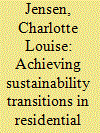

|
|
|
|
|
| Summary/Abstract |
Reducing greenhouse gas emissions in the residential sector is central to European energy policy. However, the speed and scale of sustainable energy transitions need to accelerate. There is a growing consensus that meeting energy targets is highly dependent on interrelated socio-material and cultural aspects of energy use. New ways of framing energy demand that go beyond dominant efficiency- and behavior models are needed. Recognizing these concerns, this paper reports on a review of 1067 Sustainable Energy Consumption Initiatives (SECIs) that aim to reduce residential energy use across 30 European countries. The initiatives are categorized and a corresponding Problem Framing Typology (PFT) is developed, highlighting important aspects of different types of problem framings. The typology contains four categories including 1) Changes in technology; 2) Changes in individual behavior; 3) Changes in everyday life situations; 4) and Changes in complex interactions. Applying the PFT to the 1067 SECIs shows that the vast majority (75%) of SECIs are positioned within category 1 and 2, indicating a lingering bias towards technocratic consumer behavioral strategies. The limitations of such approaches are discussed, and it is argued that systematically addressing interactions between technology, businesses, culture and everyday-life is more likely to lead to long-term transformation.
|
|
|
|
|
|
|
|
|
|
|
|
|
|
|
|
| 2 |
ID:
091702


|
|
|
|
|
| Publication |
2009.
|
| Summary/Abstract |
Electricity demand in South Africa has grown at a very rapid rate over the past decade. As part of reform initiatives to enhance long-term sustainability of the country's electricity industry, South Africa's authorities have in recent years sought to develop an electricity pricing framework that is cost reflective and forms the cornerstone of demand management schemes meant to foster changes in consumption behaviour and enhance efficiency in resource use. The effects of any pricing policy on aggregate electricity consumption will depend on a useful understanding of the factors that influence electricity demand, and the magnitude to which electricity demand responds to changes in such factors. In this context, this paper applies the bounds testing approach to cointegration within an autoregressive distributed lag framework to examine the aggregate demand for electricity in South Africa during the period 1960-2007. The results indicate that in the long run, income is the main determinant of electricity demand. With electricity prices having an insignificant effect on aggregate electricity demand, future pricing policies will need to ensure that electricity prices are cost reflective and enhance efficiency of electricity supply and use.
|
|
|
|
|
|
|
|
|
|
|
|
|
|
|
|
| 3 |
ID:
132660


|
|
Analysis of monthly household energy consumption among single-f
/ Valenzuela, Carlos; Valencia, Alelhie; White, Steve; Jordan, Jeffrey A, Cano, Stephanie, Keating, Jerome, Nagorski, John, Potter, L.B
|

|
|
|
|
| Publication |
2014.
|
| Summary/Abstract |
Demographic, socioeconomic, and housing characteristics influence variation in household energy consumption. By combining household-level utility, public, and proprietary data, we examine predictors of household energy consumption in a Texas urban area. Using quantile regression, this analysis assesses the relationship between energy consumption and predictors at the middle and both ends of the distribution (10th and 90th percentiles). Results indicate potential opportunities to lower consumption among the highest energy-consuming households including those with pools, with non-central cooling, with people working from home, those built on pier/post foundation, and those that are renter-occupied. These findings suggest significant opportunities to reduce consumption and demand as in the study area, almost 10% of housing units are renter-occupied, 18% percent are without central cooling, and 7% have pools. Capturing a significant portion of these homes for retrofit conservation efforts through marketing has potential to produce substantial results. Producing a better understanding of determinants of household energy consumption using the methods presented has potential to assist development and implementation of strategies to reduce consumption and increase efficiency.
|
|
|
|
|
|
|
|
|
|
|
|
|
|
|
|
| 4 |
ID:
132634


|
|
|
|
|
| Publication |
2014.
|
| Summary/Abstract |
To alleviate the problem of the insufficient reserves of natural gas in China, coal-based synthetic natural gas (SNG) is considered to be a promising option as a source of clean energy, especially for urban use. However, recent study showed that SNG will not accomplish the task of simultaneous energy conservation and CO2 reduction. In this paper, life cycle costing is made for SNG use in three main applications in residential sector: heating, household use, and public transport. Comparisons are conducted between SNG and coal, natural gas, liquefied petroleum gas (LPG), diesel, and methanol. The results show that SNG is a competitive option only for household use. The use of SNG for heating boilers or city buses is not as cost-effective as expected. The biggest shortcoming of SNG is the large amount of pollutants generated in the production stage. At the moment, the use of SNG is promoted by the government. However, as shown in this paper, one can expect a transfer of pollution from the urban areas to the regions where SNG is produced. Therefore, it is suggested that well-balanced set of environmental damage-compensating policies should be introduced to compensate the environmental losses in the SNG-producing regions.
|
|
|
|
|
|
|
|
|
|
|
|
|
|
|
|
| 5 |
ID:
128035


|
|
|
|
|
| Publication |
2014.
|
| Summary/Abstract |
Gujarat, a large industrialized state in India, consumed 67 TWh of electricity in 2009-10, besides experiencing a 4.5% demand-supply short-fall. Residential sector accounted for 15% of the total electricity consumption. We conducted load research survey across 21 cities and towns of the state to estimate residential electricity load curves, share of appliances by type and usage patterns for all types of household appliances at utility, geographic, appliance, income and end-use levels. The results indicate that a large scope exists for penetration of energy efficient devices in residential sector. Marginal Abatement Cost (MAC) curves for electricity and CO2 were generated to analyze relative attractiveness of energy efficient appliance options. Results indicate that up to 7.9 TWh of electricity can be saved per year with 6.7 Mt-CO2 emissions mitigation at negative or very low CO2 prices of US$ 10/t-CO2. Despite such options existing, their penetration is not realized due to myriad barriers such as financial, institutional or awareness and therefore cannot be taken as baseline options for CO2 emission mitigation regimes.
|
|
|
|
|
|
|
|
|
|
|
|
|
|
|
|
| 6 |
ID:
127872


|
|
|
|
|
| Publication |
2014.
|
| Summary/Abstract |
Maximizing renewables in the country's power system has been a key political agenda in Japan after the Fukushima nuclear disaster. This paper investigates the potential of PV resource, which could be systematically integrated into the Japanese power system, using a high time-resolution optimal power generation mix model. The model allows us to explicitly consider actual PV and wind output variability in 10-min time resolution for 365 days. Simulation results show that, as PV expands, the growth of PV integration into the grid slows down when the installed PV capacity is more than the scale of the peak demand, although Japan has immense potential of installable PV capacity - equivalent to 40 times of the peak. Secondly, the results imply that a large-scale PV integration potentially decreases the usage ratio of LNG combined cycle (LNGCC) in specific seasons, which is a challenge for utility companies to ensure that LNGCC is used as a profitable compensating generator for PV variability. Finally, a sensitivity analysis on rechargeable battery cost suggests that the reason for suppressing the PV output instead of storing its surplus output by the battery can be attributed to the high battery cost; hence, the improvement of its economic performance is significant to integrate the massive PV energy.
|
|
|
|
|
|
|
|
|
|
|
|
|
|
|
|
| 7 |
ID:
179668


|
|
|
|
|
| Summary/Abstract |
There are a growing number of blockchain applications in energy systems, but surprisingly little is known about their direct energy demand outside of cryptocurrency applications. Addressing this knowledge gap should be a key policy priority so that the energy use of blockchain systems can be better understood and managed as applications proliferate. To help policy makers and energy analysts achieve this goal, this article makes three contributions. First, we present a brief review of blockchain system components, energy demand drivers, and emerging applications to provide a common conceptual foundation. Second, we propose best practices for energy analysis of blockchain systems and identify best practice lapses in previous literature that presently cloud our understanding of energy use. Finally, we propose priority research areas to address identified lapses and knowledge gaps, which would ensure future research produces data and estimates that are maximally relevant to energy policy decisions.
|
|
|
|
|
|
|
|
|
|
|
|
|
|
|
|
| 8 |
ID:
132595


|
|
|
|
|
| Publication |
2014.
|
| Summary/Abstract |
This paper quantifies the direct rebound effects associated with the switch from incandescent lamps (ILs) or halogen bulbs to more energy efficient compact fluorescent lamps (CFLs) or light emitting diodes (LEDs) using a large nationally representative survey of German households. The direct rebound effect is measured as the elasticity of energy demand for lighting with respect to changes in energy efficient lamps. In particular, the rebound effect is decomposed into changes in lamp luminosity and burn time. For the average bulb, the associated total direct rebound effect is estimated at about 6%. The larger part (around 60%) of this rebound effect results from increases in bulb luminosity. For the most frequent (modal) bulb switch, i.e. the replacement of the main bulb in the living or dining room, the total direct rebound effect is just below 3%, with around 60% attributable to an increase in burn time. Average and modal bulb differences suggest that the magnitude of the rebound effect may decrease with intensity of initial bulb use. The magnitude of the direct rebound and the relative contributions of changes in luminosity and burn time also differ by initial bulb type and by replacement bulb type.
|
|
|
|
|
|
|
|
|
|
|
|
|
|
|
|
| 9 |
ID:
150638


|
|
|
|
|
| Summary/Abstract |
China hosts a large amount of building stocks, which is nearly 50 billion square meters. Moreover, annual new construction is growing fast, representing half of the world's total. The trend is expected to continue through the year 2050. Impressive demand for new residential and commercial construction, relative shorter average building lifetime, and higher material intensities have driven massive domestic production of energy intensive building materials such as cement and steel. This paper developed a bottom-up building stock turnover model to project the growths, retrofits and retirements of China's residential and commercial building floor space from 2010 to 2050. It also applied typical material intensities and energy intensities to estimate building materials demand and energy consumed to produce these building materials. By conducting scenario analyses of building lifetime, it identified significant potentials of building materials and energy demand conservation. This study underscored the importance of addressing building material efficiency, improving building lifetime and quality, and promoting compact urban development to reduce energy and environment consequences in China.
|
|
|
|
|
|
|
|
|
|
|
|
|
|
|
|
| 10 |
ID:
132602


|
|
|
|
|
| Publication |
2014.
|
| Summary/Abstract |
In order to find efficient trade measures to reduce China×s energy consumption and to provide theoretical support for the climate talks between China and America, we investigate the impact of Sino-USA trade on energy consumption from the perspective of embodied energy. An Environmental Input-Output Life Cycle Assessment (EIO-LCA) model was established to calculate the total energy consumption coefficient, the direct consumption coefficient and the complete consumption coefficient of the sectors of the national economies of China and America. After taking into consideration the data of every sector of the national economy in Sino-USA trade, energy embodied in the import and export trade between China and America was calculated to verify the real energy flows in Sino-USA trade. The research results suggest the following: China is the net exporter of embodied energy in Sino-USA trade, and coal, crude oil and natural gas are the major components. In 1997-2011, the net exports of China×s embodied energy totaled 1523,082,200 t of standard coal, the amount of China×s energy consumption increased by 895,527,900 t of standard coal, and America×s energy consumption decreased by 11,871,200 t of standard coal as a result of Sino-USA trade. On this basis, corresponding policies and recommendations are proposed.
|
|
|
|
|
|
|
|
|
|
|
|
|
|
|
|
| 11 |
ID:
116818


|
|
|
|
|
| Publication |
2012.
|
| Summary/Abstract |
Energy demand in the twenty-first century will be driven by the needs of three billion people in the emerging world and three billion new inhabitants to our planet. To provide them with a renewable and sustainable energy supply is perhaps the greatest challenge for science in the twenty-first century. The science practiced to meet the energy needs of the twentieth century responded to a society of wealth, and energy systems were designed to be large and centralized. However, the inability of the emerging world to incur large capital costs suggests that a new science must be undertaken, one that does not rely on economy of scale but rather sets as its target highly manufacturable and distributed energy systems that are affordable to the poor. Only in this way can science provide global society with its most direct solution for a sustainable and carbon-neutral energy future.
|
|
|
|
|
|
|
|
|
|
|
|
|
|
|
|
| 12 |
ID:
132768
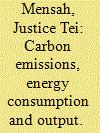

|
|
|
|
|
| Publication |
2014.
|
| Summary/Abstract |
Following the recent global economic downturn, attention has gradually shifted towards emerging economies which have experienced robust growth amidst sluggish growth of the world economy. A significant number of these emerging economies are in Africa. Rising growth in these economies is associated with surging demand for energy to propel the engines of growth, with direct implications on emissions into the atmosphere. Further, these economies are constantly being shaped by series of structural reforms with direct and indirect effects on growth, demand for energy, etc. To this end, this paper examines the causal dynamics among energy use, real GDP and CO2 emissions in the presence of regime shifts in six emerging African economies using the Gregory and Hansen (1996a). J. Econ. 70, 99-126 threshold cointegration and the Toda and Yamamoto (1995). J. Econometrics. 66, 225-250 Granger causality techniques. Results confirm the presence of regime shift effects in the long run inter-linkages among energy use, real GDP and CO2 emissions in the countries considered, thus indicating that structural changes have both economic and environmental effects. Hence, integration of energy and environmental policies into development plans is imperative towards attaining sustainable growth and development.
|
|
|
|
|
|
|
|
|
|
|
|
|
|
|
|
| 13 |
ID:
125428
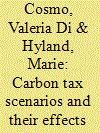

|
|
|
|
|
| Publication |
2013.
|
| Summary/Abstract |
In this paper we use annual time series data from 1960 to 2008 to estimate the long run price and income elasticities underlying energy demand in Ireland. The Irish economy is divided into five sectors: residential, industrial, commercial, agricultural and transport, and separate energy demand equations are estimated for all sectors. Energy demand is broken down by fuel type, and price and income elasticities are estimated for the primary fuels in the Irish fuel mix. Using the estimated price and income elasticities we forecast Irish sectoral energy demand out to 2025. The share of electricity in the Irish fuel mix is predicted to grow over time, as the share of carbon intensive fuels such as coal, oil and peat, falls. The share of electricity in total energy demand grows most in the industrial and commercial sectors, while oil remains an important fuel in the residential and transport sectors.
Having estimated the baseline forecasts, two different carbon tax scenarios are imposed and the impact of these scenarios on energy demand, carbon dioxide emissions, and government revenue is assessed. If it is assumed that the level of the carbon tax will track the futures price of carbon under the EU-ETS, the carbon tax will rise from €21.50 per tonne CO2 in 2012 (the first year forecasted) to €41 in 2025. Results show that under this scenario total emissions would be reduced by approximately 861,000 tonnes of CO2 in 2025 relative to a zero carbon tax scenario, and that such a tax would generate €1.1 billion in revenue in the same year. We also examine a high tax scenario under which emissions reductions and revenue generated will be greater.
Finally, in order to assess the macroeconomic effects of a carbon tax, the carbon tax scenarios were run in HERMES, the ESRI's medium-term macroeconomic model. The results from HERMES show that, a carbon tax of €41 per tonne CO2 would lead to a 0.21% contraction in GDP, and a 0.08% reduction in employment. A higher carbon tax would lead to greater contractions in output.
|
|
|
|
|
|
|
|
|
|
|
|
|
|
|
|
| 14 |
ID:
127236


|
|
|
|
|
| Publication |
2014.
|
| Summary/Abstract |
While almost 30% of UK households include children, little research has attempted to present children's perspectives on home energy use. This study used focus groups with children and parents at two primary (elementary) schools in London, UK, to explore home energy use and energy feedback. Energy was found to be a little-discussed subject at home. Children derived more motivation to save energy from responsibility conferred by school activities than other (e.g. environmental) concerns, and some connected energy saving with dangers of using electricity (e.g. fire). Material and social constraints (e.g. access to outside space, parents' environmental attitudes) meant that it was sometimes difficult for children to save energy even when motivated. However, parents showed greater inclination to pay attention to energy saving when framed as supporting their child's learning than as a financial or environmental concern. Children were disinclined to reduce energy-consuming activities such as watching television, and while parents complained about children's energy use most saw it as a low priority issue. Policy implications of these findings are considered, and the approach employed is argued to be an effective way of investigating children's perceptions around energy use.
|
|
|
|
|
|
|
|
|
|
|
|
|
|
|
|
| 15 |
ID:
135524
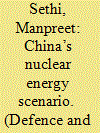

|
|
|
|
|
| Summary/Abstract |
China’s rapid socio-economic transformation, which is today being studies as a model of unprecedented economic growth, was enabled by a phenomenal surge in electricity production and consumption. from a total electricity production base of only 282 billion kilowatt hours (kWh) in 1979, china is today the largest electricity producer at 4604 billion kWh (compared to India’s 835 billion kWh).
|
|
|
|
|
|
|
|
|
|
|
|
|
|
|
|
| 16 |
ID:
127299


|
|
|
|
|
| Publication |
2014.
|
| Summary/Abstract |
China has proposed its 2020 clean energy target together with the climate change target of reducing CO2 intensity of the economy by 40-45% below the 2005 level. This article investigates the feasibility of these targets by testing their consistency under possible economic development scenarios. We analyse these targets from two perspectives: consistency with the overall economic growth and consistency with the international society's expectation on China's greenhouse gas (GHG) abatement responsibilities. The main findings are: under the recently announced 2020 target of gross domestic product (GDP) that is double the 2010 level, the adoption of a 15% clean energy target could result in excessive primary energy demand; and then with 40-45% GDP CO2 intensity reduction, CO2 emissions in 2020 could substantially exceed the International Energy Agency (IEA) 450 ppm scenario for China. Thus we propose a 17% clean energy target that can reconcile the domestic plan with international expectation. Our article also outlines the pathways to realise clean energy development into 2020 and proposes policy recommendations.
|
|
|
|
|
|
|
|
|
|
|
|
|
|
|
|
| 17 |
ID:
115689
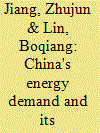

|
|
|
|
|
| Publication |
2012.
|
| Summary/Abstract |
China is currently in the process of industrialization and urbanization, which is the key stage of transition from a low-income country to a middle-income country and requires large amount of energy. The process will not end until 2020, so China's primary energy demand will keep high growth in the mid-term. Although each country is unique considering its particular history and background, all countries are sharing some common rules in energy demand for economic development. Based on the comparison with developed countries, here, we report some rules in the process of industrialization and urbanization as follows: (1) urbanization always goes along with industrialization; (2) the higher economic growth is, the higher energy demand is; (3) economic globalization makes it possible to shorten the time of industrialization, but the shorter the transition phase is, the faster energy demand grows; (4) the change of energy intensity presents as an "inverted U" curve, but whose shape can be changed for different energy policy. The above rules are very important for the Chinese government in framing its energy policy.
|
|
|
|
|
|
|
|
|
|
|
|
|
|
|
|
| 18 |
ID:
124444
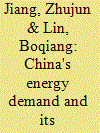

|
|
|
|
|
| Publication |
2013.
|
| Summary/Abstract |
Zhang and Qin (2013) argued that in Jiang and Lin (2012), the equation form and variable selection should be altered, and it was problematic to use regression equation to project the future. In this reply, we disagree with and will refute some of the points raised in their comments. The model that we established was based on the mature economic theory; with the variable selections all having economic implications. Considering the economic development stage, China's urbanization will speed up and this will have significant effect on energy consumption. Therefore, urbanization is an indispensable variable for analyzing energy demand in China. The scenario design only in terms of the GDP is sufficient for illustrating energy demand trend in China to be understood in a way by most of the people. Although energy forecast is not that precise, it has an important implication for energy policy design, especially for China which is in transition. And China's energy demand will keep high growth in the mid-term.
|
|
|
|
|
|
|
|
|
|
|
|
|
|
|
|
| 19 |
ID:
091072
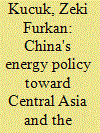

|
|
|
|
|
| Publication |
2009.
|
| Summary/Abstract |
China has very interesting conditions. China has to overcome its energy hunger in order to continue its economic boom. However, China has an enormous population, which makes it very different from the other developing countries. In order to feed its 1.3 billion people and huge economy, China needs much more energy than other developing countries.
|
|
|
|
|
|
|
|
|
|
|
|
|
|
|
|
| 20 |
ID:
191309
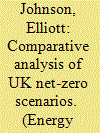

|
|
|
|
|
| Summary/Abstract |
Final energy demand in the UK has remained relatively constant since the 1970s. However, most of the scenarios that model pathways to achieve the UK's net-zero greenhouse gas emissions by 2050 indicate that energy demand reduction (EDR) will be an important pillar of climate change mitigation. Despite this, the UK Government has no clearly defined strategy to reduce demand. This comparative analysis explores the role of EDR across twelve UK-based climate scenarios from four organisations that estimate changes in carbon emission and energy consumption from 2020 to 2050. We focus on changes in final demand across the economy, assessing the scale of ambition and the implications for the rest of the energy system in the context of net-zero. All the pathways explored achieve reductions of at least 32.8% in total final energy demand from 2020 to 2050, suggesting that this is the minimum level of demand reduction required to achieve the development and rollout of the supply side technologies necessary to decarbonise the energy system. Reductions in total final demand of up to 52% are demonstrated. We find that pathways with higher levels of EDR mitigate against technological challenges, such as scaling up renewable energy capacities, are less reliant on carbon-dioxide removal technologies and require less investment – but are characterised by higher levels of social change.
|
|
|
|
|
|
|
|
|
|
|
|
|
|
|
|
|
|
|
|
|